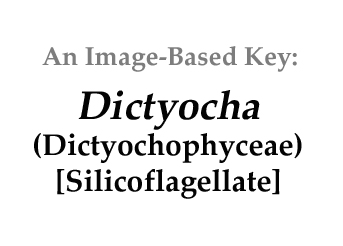|
|
||||
|
|
||||
|
Click on images for larger format |
||||
Name derivation: |
||||
|
From the Greek diktyon, a net, and ochos, anything that bears or holds - presumably in reference to the basket-like skeleton. |
||||
Classification: |
||||
|
Dictyocha Ehrenberg 1837; 11 of 293 species are currently accepted taxonomically (Guiry and Guiry 2013). Class Dictyochophyceae; Order DictyochalesChang (2001) recognizes only four extant species: D. fibula, D. speculum. , D. octonaria Ehrenberg (Henriksen et al. 1993) and D. californica Schrader & Murray (Hernández-Becerril &Bravo-Sierra 2001).
|
||||
Morphology: |
||||
|
Unicellular flagellate with up to five life-history stages having different morphologies. One is a uninucleate, silica skeleton-producing form with a single ring and several connecting bars; it is followed by a multinucleate amoeba-like stage, which is followed by a uninucleate naked stage. The naked-stage cell bears heterokont flagella, a long flagellum, with stiff lateral hairs known as mastigonemes, and a very short vestigial smooth flagellum. Only the long flagellum is apparent in the skeleton-bearing stage. The skeleton is made of silica and is shaped like a flat basket.
|
||||
Similar genera: |
||||
|
Dictyocha is the only known extant genus of silicoflagellates. The genus name Dictyocha is recognized over Distephanus, the latter considered to be illegitimate (Moestrup & Thomsen 1990). However, differences in the silicon-based skeleton have been used to separate Distephanus (six-sided) from Dictyocha (four-sided) (KcCartney, K., and D.E. Loper 1989).
|
||||
Life cycle in culture: |
||||
|
Van Valkenburg and Norris (1970) were the first to successfully maintain a unialgal culture of a silicoflagellate. They observed a high degree of plasticity in Dictyocha fibula skeletons that essentially negated several species and even genus descriptions. Optimal growth is at 10 C and 24‰ salinity, in Provasoli enriched seawater medium. Cells were observed with and without a skeleton, and both flagellated and nonflagellated. Based on cell culture, the unicells with a silica skeleton morph into naked resting cells attached to each other with cytoplasmic extensions. These in turn morph into large naked multinucleate coenocytes. The next stage is a population of naked flagellated unicells, then a 'transitional multinucleate stage followed by another large multinucleate coenocyte that most likely produces a new generation of skeleton-bearing flagellated unicells (Henriksen et al. 1993).
|
||||
Habitat: |
||||
|
Marine. Dictyocha is widespread throughout the world's oceans but is more prevalent in cold waters, where it can form blooms. In culture growth of naked cells is maximum at 10 – 15 C and salinities of 20 – 25 ‰ ( Henriksen et al. 1993). Blooms of the naked flagellated unicell stage have become common in the Western Baltic with increasing eutrophication, and were first observed in 1983 (Jochem and Babenerd 1993).
|
||||
Limited Toxicity to Fish: |
||||
|
Incubation of salmon in seawater with cultured naked unicells of Dictyocha resulted in some production of mucus on gills that would have reduced the fish tolerance to reduced oxygen levels. No other organs were affected. Similarly mice injected with the Dictyocha cells expressed no effects Henriksen et al. 1993). |
||||
References: |
||||
|
Chang, F.H. 2015. Cell morphology and life history of Dictyocha octonaria (Dictyochophyceae, Ochrophyta) from Wellington Harbour, New Zealand. Phycological Research 63:253-264. Graham, L. and L. Wilcox 2000. Algae. Prentice-Hall Guiry, M.D. and G.M. Guiry 2013. AlgaeBase. World-wide electronic publication, National University of Ireland, Galway. http://www.algaebase.org; searched on 30 April 2013. Henriksen, P., F. Knipschildt, O. Moestrup and H.A. Thomsen 1993. Autecology, life history and toxicology of the silicoflagellate Dictyocha speculum (Silicoflagellata, Dictyochophyceae). Phycologia 32(1):29-39. Hernández-Becerril, D. U. and E. Bravo-Sierra 2001. Planktonic silicoflagellates (Dictyochophyceae) from the Mexican Pacific Ocean. Botanica Marina 44: 417–23. Jochem, F., and B. Babenerd 1989. Naked Dictyocha speculum -- a new type of phytoplankton bloom in the Western Baltic. Marine Biology 103(3):373-379. Lee, R.E. 1999. Phycology 3rd ed. Cambridge University Press Moestrup, 0. & H.A. Thomsen 1990. Dictyocha speculum (Silicoflagellata, Dictyochophyceae), studies on armoured and unarmoured stages. Biologiske Skrifier 37: I-56. Van Valkenburg, S.D., and R.E. Norris 1970. The growth and morphology of the silicoflagellate Dictyocha fibula Ehrenberg in culture. Journal of Phycology 6:48-54. |
||||





